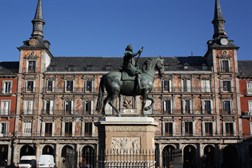Philip III and the Plaza Mayor in Madrid
 The fourth son of Philip II and his fourth wife, Anne of AustriaAnne of Austria (1549-1580) was the eldest daughter of Emperor Maximilian II and Maria of Spain, the daughter of Charles V (1500-1558). Initially promised to her cousin, the infante Don Carlos, she eventually married her uncle, King Philip II of Spain (1527-1598) in 1570. In ten years of marriage, Anna gave birth to princes Ferdinando, Carlos Lorenzo, Diego Félix, Felipe (later King Philip III, 1578-1621) and Mary., Philip III ascended to the throne after the death of his father, in 1598, the only survivor among the sons of the rey prudente. Known to history as a king driven by deep religious devotion, as well as a passion for riding and hunting, Philip III chose to give the exercise of power, delegating almost everything to the courtier who more than anyone enjoyed his favour and his confidence: Francisco Gómez de Sandoval y Rojas, the Duke of Lerma (1553-1625). This decision marked the beginning of a practice of government, centered on the figure of the king’s favourite, or valido, that would be used by the next king, Philip IV, and even outside the confines of the Habsburg monarchy. In foreign policy, the reign of Philip III was characterized initially by an attempt to put an end to the numerous wars started under the former sovereign, as is exemplified by the peace treaty with England (1604) and the Twelve years’ truce with the United Provinces (1609). The outbreak of some minor conflicts, especially in the Italian peninsula, and the decision to go to war alongside the Austrian Habsburgs in the conflict that would become known as the Thirty Years’ War (1618-1648), however, contributed to ruin the image of Philip III as a peace-loving ruler. Another decision loaded with consequences for the subsequent evolution of Spanish history was to authorize the expulsion, between 1609 and 1614, of three hundred thousand Moriscos, descendants of Muslim subjects forcibly converted during the Reconquista.
The fourth son of Philip II and his fourth wife, Anne of AustriaAnne of Austria (1549-1580) was the eldest daughter of Emperor Maximilian II and Maria of Spain, the daughter of Charles V (1500-1558). Initially promised to her cousin, the infante Don Carlos, she eventually married her uncle, King Philip II of Spain (1527-1598) in 1570. In ten years of marriage, Anna gave birth to princes Ferdinando, Carlos Lorenzo, Diego Félix, Felipe (later King Philip III, 1578-1621) and Mary., Philip III ascended to the throne after the death of his father, in 1598, the only survivor among the sons of the rey prudente. Known to history as a king driven by deep religious devotion, as well as a passion for riding and hunting, Philip III chose to give the exercise of power, delegating almost everything to the courtier who more than anyone enjoyed his favour and his confidence: Francisco Gómez de Sandoval y Rojas, the Duke of Lerma (1553-1625). This decision marked the beginning of a practice of government, centered on the figure of the king’s favourite, or valido, that would be used by the next king, Philip IV, and even outside the confines of the Habsburg monarchy. In foreign policy, the reign of Philip III was characterized initially by an attempt to put an end to the numerous wars started under the former sovereign, as is exemplified by the peace treaty with England (1604) and the Twelve years’ truce with the United Provinces (1609). The outbreak of some minor conflicts, especially in the Italian peninsula, and the decision to go to war alongside the Austrian Habsburgs in the conflict that would become known as the Thirty Years’ War (1618-1648), however, contributed to ruin the image of Philip III as a peace-loving ruler. Another decision loaded with consequences for the subsequent evolution of Spanish history was to authorize the expulsion, between 1609 and 1614, of three hundred thousand Moriscos, descendants of Muslim subjects forcibly converted during the Reconquista.
Among the merits of the reign of Philip III the redevelopment of Madrid should be mentioned. The Plaza Mayor was completed in 1619 under the direction of Juan Gómez de Mora, and became the centre from which the streets of the capital would radiate in subsequent years. The equestrian statue of Philip III is situated today at the centre of the Plaza Mayor, begun by GiambolognaJean de la Boulogne known as Giambologna (1529-1608) was a Flemish sculptor working in Italy, the contact point between the Renaissance and the Baroque. Arriving in Rome in 1550 for artistic training, on the way back he stopped in Florence. After a short time he began working for the Medici, becoming the most popular sculptor. He also worked in Lucca, Genoa and Bologna. Among his works are the Rape of the Sabine, the Fountain of Neptune and the equestrian statues of Cosimo I and Ferdinand I. and completed by his pupil, Pietro TaccaPietro Tacca (1577-1640) was one of the main representatives of the Baroque style in Italy. A pupil of Giambologna, he is best known as the author of the equestrian statues of Philip III and Philip IV of Spain. He made an equestrian monument for the king of France, Henry IV, which, however, was destroyed during the French Revolution. Other valuable works of his are the Four Moors chained to the base of the monument to Ferdinand I de’ Medici at Livorno and the two bronze fountains of Piazza Santissima Annunziata in Florence., in 1616. The current location of the sculpture was decided by Queen Isabella II in 1848.
